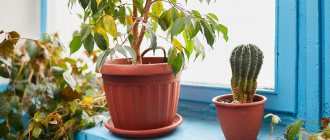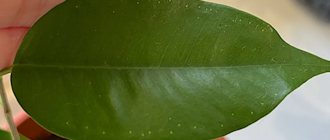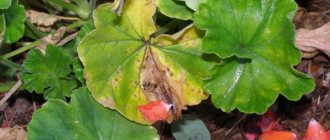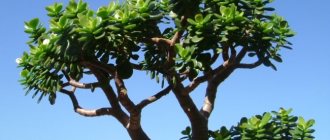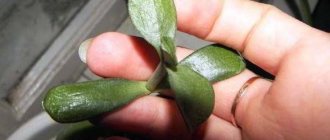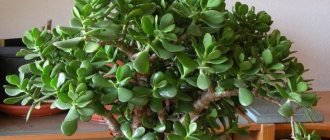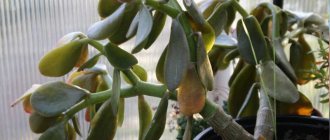Money Tree December 18, 2016 3566
Home » Houseplants » Cacti and succulents » Money tree
Money tree, Crassula, Crassula, which are now often found in any interior - home and office, have gained popularity for their rare unpretentiousness, medicinal properties and beauty. However, often lovers of indoor flowers are forced to ask the question - why do the leaves of the money tree fall? What is the cause of this scourge, how to deal with it?
Why are the leaves falling off the money tree?
Loss of leaves in Crassula is the most common problem in its cultivation and maintenance. The most common reasons:
- the watering regime is disrupted;
- excess direct sunlight;
- overfeeding with mineral fertilizers;
- unsuitable water for irrigation;
- sharp fluctuations in daily temperature;
- diseases, pests;
- the natural aging process of the money tree.
Important! The leaves of the money tree also fall when it is preparing to put out a new branch instead of a leaf. In this case, there is nothing to worry about, as well as with the loss of lower leaves on the trunk.
Frequent or excessive watering, or a combination of both, is the most common reason. Crassula is a succulent in which nature itself provides for abstinence from abundant moisture supply to the roots. Excess water can cause root rot. Drying out roots is less harmful to the money tree.
When overwatered, the fat plant simply sheds its leaves, as if getting rid of water ballast. And if it lacks moisture, the leaves begin to wither, lose their elasticity and fall off.
Excessive direct sunlight for the light-loving Crassula can also cause leaf fall. This is especially important in the summer, when the tree often goes to “rest” in the open air. This is due to the fact that the leaves of the money tree heat up, their tissues lose their elasticity and vitality.
A somewhat rarer cause of leaf fall is excess mineral fertilizers. The increased salt content in the soil, which is a consequence of overfeeding, leads to disruption of metabolic processes in the plant.
Unsuitable water for irrigation - that is, cold water straight from the tap - also harms the fat plant. Cold water is poorly absorbed by the root system, which is why it stagnates in the substrate. Unsettled tap water contains chlorine, which is poisonous to plants.
Sharp fluctuations in daily temperature become a source of stress for the plant, to which the money tree reacts by dropping its leaves.
Important! The money tree is equally harmed by both very low and very high temperatures.
Crassula is extremely resistant to diseases and pests, however, systematic violation of the rules of care weakens the plant and reduces its natural immunity.
With good care, a money tree can live for more than 20 years, but it ages just like all living things.
Main reasons
Drying of money tree leaves occurs for many reasons. Insufficient watering is the most common mistake made by inexperienced gardeners.
But the plant may lose its attractive appearance due to:
- inappropriate lighting;
- diseases;
- unsuccessful transplantation;
- incorrectly chosen pot;
- being near a hot heater;
- frost or strong sun.
The reason for drying of the leaves can be heat from the battery in the winter or stagnation of water inside the pot. The roots begin to rot and the plant loses its crown. If the leaves first turn red on the outside before drying, then the cause is strong sun. Internal redness before the final death of the leaves is the result of insufficient watering.
It is necessary to correctly determine the cause in order to eliminate the problems that have arisen.
Improper watering
Leaf drying is usually caused by water. Water the money tree once or twice a week in the summer and once a month in the winter. If you flood a plant, you can destroy it in a short time. The leaves of the fat plant are large, but this does not mean that it loves moisture very much.
The main reasons for the drying of leaves of Crassula:
- insufficient watering;
- adding water every morning or evening (leads to rotting of the root system);
- watering at low temperatures (for example, in the fall on the balcony).
The money tree loves water that has previously settled for several days on the windowsill. The liquid should not be too cold or hot. It is preferable to choose melt water.
To avoid the plant drying out, it is advisable not only to water the fat plant, but also to periodically give the plant a “shower”. The leaves should be clean and shiny.
You can do this in the bathroom or just use a spray bottle. This procedure imitates the real conditions in which the crassula grows in warm countries (Cyprus, Greece, etc.).
Thin leaves of the Crassula indicate insufficient watering. Gradually they become thinner, and then dry out completely.
Lighting
Lack of sun or, conversely, too much heat can also cause leaves to dry out. The money tree loves good, but not strong, lighting.
Usually the plant is placed on the sunny side, where it is exposed to sunlight for most of the day. But if the sun's influence is too strong, it can be harmful. The leaves begin to dry out even if they do not have enough light. For example, if the pot is in a dark room or far from the window.
If the fat plant begins to dry out from the heat, try moving the pot to a less lit side. For example, not to the south, but to the southeast.
Temperature violation
Dry leaves on the plant may also appear when there is a violation of the temperature regime. The fat woman does not like the cold, because her homeland is exclusively southern countries. The optimal summer temperature is not lower than +18 degrees.
Temperature:
- When the thermometer drops sharply below +10 degrees, the money tree experiences shock.
- When exposed to conditions with zero temperature, the plant dies.
The ideal temperature for a money tree is +20...+25 degrees, moderate but sufficient sunlight. You should not keep the fat woman on the balcony for a long time if autumn has begun. At night it can become very cold and the plant will die.
Frostbite in Crassula manifests itself in limp and wrinkled leaves, which gradually dry out and fall off. In this case, it will be very difficult to save your pet.
cramped potty
Sometimes, for the sake of beauty, money trees are sold in very tight decorative pots. This is definitely harmful to its health and can lead to drying of the leaves. You need to transplant the fat plant into a normal pot.
Money tree roots are small in volume, but they require sufficient space. A small container can only be chosen if the plant is still small. Then it will need to be replanted.
But an overly large pot is also evil. This can lead to improper distribution of moisture and rotting of the roots. Choose the middle option.
Transplantation is carried out no more often than once every two to three years.
Feeding
If the money tree weakens and withers, and the grower does not take any action, the result will be disappointing. It is necessary to review watering, lighting and fertilizing with special means.
Use the following products to feed the fat plant strictly according to the instructions:
- Etisso;
- Bona forte;
- Pokon and other fertilizers.
Avoid using the wrong fertilizers as they can kill the Crassula. For example, overdosing drugs with nitrogen is harmful. It is necessary to choose products with potassium, phosphorus, calcium, iron and nitrogen together.
A lack of vitamins can be indicated by yellowing and drying leaves of the plant. At first they change color, and then fall off at the slightest pressure. But this phenomenon should not be confused with seasonal renewal of leaves.
Transplantation and cuttings
The money tree tolerates the procedure of transplantation and cuttings relatively calmly. But if you tear the plant out of the pot or tear off the roots, it can still dry out.
Transplant rules:
- Carefully remove the lump of earth from the pot and transfer it to a new container.
- Make sure that all roots are inside the ball.
- After transplanting, water the fat plant, because this way it will more easily withstand the stress of transplantation.
The money tree is very fragile and sometimes sheds small branches with leaves, which are then used for propagation. But one leaf is enough to grow a new plant.
To prevent the leaf from drying out, take a pot, make drainage and fill it with soil mixture. Moisten the soil and carefully place a leaf or branch with roots, then be sure to water.
You shouldn’t cut off the fat plant too much for cuttings. A small branch or leaf is enough.
Damage by diseases and pests
If the leaves of the fat plant dry out and become covered with growths, then the tree is sick. This can also be indicated by cobwebs on the branches and a powdery coating on the drying crown.
If bad symptoms appear:
- The tree is washed and often replanted in another soil. The sooner the plant leaves the contaminated habitat, the better. The appearance of not only dryness, but also a black coating on the leaves indicates a serious infection. In this case, all infected parts are removed and the affected roots are disposed of.
- Sometimes soaking the roots of the fat plant for 20 minutes in potassium permanganate helps. Regular laundry soap can also remove infections. You need to dilute the soap solution and wash the damaged areas.
The fat woman can be attacked by very small insects that resemble fleas. They can be seen on or near the soil. They may appear if the money tree is flooded with water or jump from other flowers.
There may also be a tick or thrips invasion. To combat insect pests, use Fufanon and Actellik strictly according to the instructions; Apollo also helps.
It is imperative to get rid of pests. Otherwise, the plant will dry out completely and die. To process wood, place it in a larger basin. This will make it convenient to pour the desired solution over it and avoid splashing the drug all over the room.
What to do to prevent leaves from falling
Strict adherence to the watering regime. In the summer, you need to water your indoor money tree flower daily, but in moderation. In the fall, watering is gradually reduced, reducing it to once a week by the beginning of winter.
This regime is maintained until the beginning of spring, when the plant resumes active growth. Then watering begins to gradually increase.
If the money tree is located near a south window, it needs shading on hot days. If you take it out into the open air in the summer, you need to choose a place so that after 11 o’clock it is in the shade.
To ensure that feeding of the fat plant does not turn out to be excessive, you need to carefully study the instructions for fertilizers and apply them in strict accordance with the instructions.
Water for watering the money tree should sit for at least a day and be at room temperature. The ideal water for irrigation is soft. It is better to boil tap water that is too hard.
To avoid sudden changes in daily temperature, you need to take a responsible approach to choosing a location. The fat woman does not like drafts or heat from heating appliances. Situations often arise when one part of the pot is exposed to the cold from the window, and the other suffers from the heat of the radiators.
Important! If such situations cannot be avoided, it is necessary to provide protection from hot and cold air flows - light screens made of thick paper, cardboard or foam.
Unfortunately, it is impossible to prevent the aging of the money tree. It is possible only at the first signs of its manifestation (falling leaves, cessation of flowering, softening of the trunk) to take measures to rejuvenate it.
Why do the leaves become limp and fall off?
In addition to the main reasons for the loss of leaves on the money tree described above, there are several more that are directly related to the characteristics of caring for the plant at different times of the year.
In summer, the money tree must be protected from the scorching sun, drying out of the soil and too dry air, drafts and overheating of the substrate in the pot. It should be watered daily, moderately, in the evening, removing excess moisture from the pan.
In the fall, it is important to bring the money tree indoors in time. Night cold temperatures below 10ºC can cause hypothermia of the root system, which can cause disease or stress.
In winter, you should not place a money tree near heating appliances. In the short days of late autumn and until mid-winter, the plant needs additional lighting. The optimal length of daylight for a money tree is 10-12 hours; based on this condition, it is provided with additional lighting.
Another winter problem is dry indoor air. Although the fat woman is indifferent to humidity, once a month she will benefit from a small warm shower.
Important! From mid-autumn until spring, the money tree is not fed. Fertilizing during this period can also cause leaf fall.
There are a number of other problems that lead to the leaves of the fat plant falling off, but they relate to the plant’s habitat.
Money tree is an energetically powerful plant. It is strongly connected with its owners, often falling ill with them. Therefore, it often happens that the tree begins to wither if one of the household becomes seriously ill.
If the money tree is kept under normal conditions and its care is carried out “according to the textbook,” experienced flower growers advise paying the owners’ attention to their own health.
Often, exacerbations of chronic diseases of family members have a negative impact on the plant: it grows poorly, the leaves wither and fall off. Here it is not the plant that needs to be treated, but people. With the recovery of the owners, the money tree quickly comes to its senses.
Also, the energetic connection between the fat woman and family members is clearly expressed when conflict situations arise. If quarrels, scandals, and conflict situations often occur in the house, the money tree, like a tender young lady, begins to mope, expressing its protest by dropping leaves. And in this case, it is not the plant that needs help, but people. When home calm and peace are restored, the tree will also be restored.
Crassula
This is interesting! Crassula or “money tree”, as it is popularly called, is a symbol of wealth and prosperity. The size of the leaf plate indicates the degree of wealth of the owner: if they are large, then the person will not need anything, since everything is in order with his money and vice versa.
The plant itself is unpretentious in care, so it is popular among novice gardeners. It can remain without moisture for a long time, since the leaves have the ability to accumulate it. But, if the main problem is that the fat plant begins to turn yellow and shed its leaves. What to do?
Historical fact! South Africa is considered to be the ancestor of the Crassula. Translated from Latin, it is also called Crassula from the succulent genus (plants with special tissues capable of storing water). There are about 350 thousand tree species, the popularity of which grows mainly in the Southern Hemisphere.
- Causes of fat leaves falling off and turning yellow: preventive actions
- Tips for caring for Crassula: drugs and their use
- Conclusion
Money tree leaves wither reasons
The situation when the leaves of the money tree become limp and wrinkled is not much less common than its fall. This can be caused by several reasons:
- Excessive watering. The most unpleasant thing is that when overwatering, the root system of the money tree suffers significantly: it begins to rot. Even worse, the leaves become limp only when the rotting process has already begun.
- Inappropriate pot. In a cramped pot, the root system does not have the opportunity to fully develop, which immediately affects the condition of the plant. It is also undesirable to have a container that is too large, since this creates a threat of excess moisture in the substrate.
- Violation of containment conditions. Limp and wrinkled leaves of a money tree are a sign that it suffers from either frequent drafts or lack of light. On the other hand, prolonged exposure of the fat plant to the bright sun in the hot summer also leads to wrinkling of the leaves.
Important! Often, when the leaves become lethargic, inexperienced indoor plant lovers wonder: how to feed the fat plant? There is only one answer: it does not need additional feeding; rather, on the contrary, it can cause even more harm to the plant.
Why does the barrel break?
The money tree is very powerful and heavy. The trunk must be able to withstand heavy leaves and branches. The root system of the plant is superficial, so at the slightest tilt the Crassula runs the risk of falling out of the pot.
Important! Proper watering and crown formation will save the trunk from breaking.
It often happens that a tree grows for several years, its branches and trunk develop successfully, it pleases with its appearance, and at one moment it breaks for no apparent reason. The main culprits of the breakdown may be:
- improperly formed crown;
- excessive watering;
- one-sided position in relation to sunlight.
The money tree grows actively in the spring and summer, its branches grow quickly and uncontrollably, unlike the trunk. If the crown is not formed in time, it will break the tree under the influence of its weight or tear it out of the pot, since the superficial root system is not able to support the entire plant, like the one that develops in an adult oak with a huge crown. Therefore, every autumn you should shape the plant, measuring the strength and height of the trunk with the length of the branches.
Broken rotten trunk
Caring for crassula at home does not require constantly wet soil. This desert plant easily survives drought, accumulating nutrients in its fleshy leaves. Its roots are sensitive to waterlogging. Constantly present moisture in the soil can provoke fungal infection of the roots or root rot, which rapidly spreads throughout the underground part of the plant, causing it to begin to disappear. Therefore, each subsequent watering can be carried out only after the soil has completely dried.
How to save a money tree from falling if watering is carried out in compliance with the main conditions, and the crown is pruned, but it still tilts? You need to regularly turn the pot on the window, first one side, then the other. When the flower is positioned one-sidedly in relation to the sun, the foliage stretches from all sides towards the window, shifting the center of gravity.
Why do the leaves turn yellow?
Yellow leaves of the money tree are a signal that it does not have enough light. Crassula needs bright, diffused light, so it is recommended to place it near windows that face east, south or west.
If this is not possible, and also in conditions of short daylight hours in winter, the plant needs additional lighting. In addition, yellowing of the leaves is an almost constant companion to the most common problem with the money tree - leaf drop.
Why does the appearance of leaves change?
The small and swollen leaves of the indoor plant are very similar to coins, which is why the second name of the ornamental crop is “money tree”. This plant is quite unpretentious , and, perhaps, is one of the most resistant indoor flowers to damage by all kinds of diseases. A significant part of Crassula diseases in indoor floriculture is not associated with damage by plant parasites and pathogenic microflora, but is a consequence of improper care and violations of crop farming practices.
Signs associated with falling leaves
It is generally accepted that the falling leaves of the money tree certainly mean impending losses - material, moral, and in terms of health.
There is another opinion. If you look closely at the dry fallen leaves of the money tree, they will look like slightly dusty gems. This similarity is recommended to be used as a very powerful talisman to attract money. Dry leaves are collected and placed in a special bag, which is kept in the wallet.
Before you accept any sign for yourself as the most likely, you still need to remember that this phenomenon - leaf fall - is just a way for the money tree to reproduce in natural conditions and grow - in the place of the fallen leaf, a bud soon appears, from which it develops new escape.
How to save a money tree
Whatever problem arises with the leaves of the money tree, the very first action should be to restore normal conditions for its maintenance and care.
Important! All problems that may arise when growing a money tree are primarily associated with violation of the rules for caring for it.
Most often, when normal conditions are restored, the fat woman completely returns to normal after one and a half to two weeks. But in severe cases, special measures must be taken to restore the plant to a healthy, beautiful appearance.
If the money tree has suffered from excess moisture, stop watering until the soil is completely dry, and then begin to water very moderately, gradually increasing it to normal. The norm for Crassula is watering once every one or two days in the summer, and once a week in winter.
In advanced cases, when the roots have begun to rot due to excess moisture, only replanting the money tree will help. In this case, you need to carefully shake off the old soil from the roots, let them dry a little and carefully inspect them.
All rotten and broken roots must be cut with a disinfected tool, and the sections should be sprinkled with crushed charcoal or cinnamon powder. If the money tree sheds its leaves due to insufficient moisture, the situation can be easily corrected by restoring normal watering.
Important! It is unacceptable to “help” the plant by watering it beyond the norm.
If excess fertilizer is applied, the plant must be transplanted into fresh substrate. The best would be specialized soil for cacti and succulents. To subsequently avoid the threat of substrate salinity, as well as to prevent the appearance of rot, a small amount of crushed charcoal is immediately added to it. The drainage layer must be at least 2 centimeters thick.
To eliminate the consequences associated with exposure to direct sunlight, it is enough to move the plant to a shaded place. If this is not possible, during especially strong sun hours it should be shaded using any available means - from a newspaper to an ordinary umbrella.
sunburn on money tree leaf
In winter, the money tree pot should be kept away from heating appliances. You can also block it from the flow of hot air. It will be useful to lightly spray the fat plant with warm water once a week.
What to do?
With dried leaves
Watering the plant once a week in the summer months and twice a month in the winter is enough. Also, if the leaves of the fat plant begin to dry out, you should pay attention to the lighting. On summer days, the plant is removed from the sunny side or shaded.
If the whole plant has dried out altogether
If the tree has dried out completely, you can use two methods:
- Replant into a new pot and soil.
- Wash the old pot thoroughly with soapy water and scald with boiling water. Also rinse the succulent with warm water and treat it with Fitosporin or Fundazol and plant it in new soil.
Preparations such as Aktara and Fitoverm, which should be used to treat wood, help in pest control.
Traditional methods will also help:
- spraying with infusion of garlic or tobacco dust;
- washing with a soap solution, which is then washed off;
- wiping leaves with kerosene or alcohol when damaged by pests.
Money tree pests and how to deal with them
There are a lot of pests that can cause damage to the money tree. However, they are reluctant to deal with a healthy plant. But if the tree is not cared for correctly, it can quickly become a victim of insects.
Most often, a weakened fat woman is attacked by:
- mealybugs, mealybugs and rootbugs;
- scale insects and false scale insects;
- spider mite and greenhouse mite;
- nematodes, thrips and aphids.
Mealybug, a sap-sucking insect, 3-5 mm in length, usually lives in the axils of leaves. It can also be recognized by its powdery white cocoon, in which the female lays eggs.
The usual method of control is to manually remove insects using a stream of warm water and then wipe the plant with a vodka infusion of garlic or calendula. You can also use chemical insecticides, Actellik or Fufanon. Treatment is carried out weekly for 5-6 weeks.
The root mealybug is a more dangerous parasite because it settles in the ground - on the roots and root collar. From one plant, a root mealybug can spread into neighboring pots, because with abundant watering, it crawls out of the pot through the drainage holes and looks for a new victim. Since it lives in the ground, it is difficult to detect.
Important! When replanting a money tree, you need to carefully inspect its roots in order to detect the presence of a pest in time.
The safest way to combat it is to rinse the roots of the plant under a strong stream of warm water. Treatment with Fufanon (0.1%) or Actellik (0.2%) is also suitable. To do this, every 5-7 days the soil is thoroughly watered with an insecticide solution. The procedure is carried out at least five times.
Scale insects and false scale insects are also sap-sucking pests. It is not easy to recognize them, since the color of their shield often matches the color of the trunk or leaf. The fight against scale insects is difficult, since their shield can withstand almost all chemicals.
Therefore, it is usually scraped off by hand, and then the plant is treated with vodka infusions of garlic, celandine, and pine needles. A good effect is obtained by washing the affected areas with kerosene, as well as laundry soap, zoo shampoos, and strong dishwashing detergents (such as Ferry Platinum).
In cases where home remedies do not help, use insecticides that are safe for use in enclosed spaces - Actellik, Fufanon, Arrivo, Karate. Treatment is carried out at least 6-7 times with an interval of 5-7 days.
Spider mites and greenhouse mites most often settle on young leaves and shoots, since they have thinner skin. The condition for their spread is increased dry air. Mites infect a plant very quickly, and in most cases “break” its decorative form.
If this pest is detected, you urgently need to increase the air humidity, spray well or pour cold water over the entire plant and its neighbors. Homemade, natural remedies that help get rid of ticks include infusions of yarrow or chamomile, garlic or onions, tobacco or potatoes. From chemical agents, preparations and means of combating scale insects are suitable.
Nematodes are filamentous worms that parasitize on roots, forming swellings on the latter - galls. Outwardly, damage by nematodes does not affect the plant, but their presence indicates a slowdown and sometimes cessation of tree growth.
If swelling on the roots is detected during transplantation of the money tree, the damaged roots are cut to the base. You can also use the medical anthelmintic drug Pirantel. Make a solution (250 grams per 10 liters of water) and water the affected plant generously twice with an interval of two weeks.
In advanced cases, it may be easier to re-cut the money tree.
Thrips, also classified as sap-sucking pests, are also capable of transmitting viral diseases, so they are currently considered the most dangerous of the pests. Typically, their massive accumulations occur during the flowering period, when they penetrate the buds. After the money tree blooms, they move to its lower parts.
Home remedies in the fight against thrips are in most cases useless, so you have to turn to chemicals for help: Actellik, Fufanon, Tsimbum, Karate. You can use Fitoverm.
Aphids usually end up on the property along with street soil or from neighbors, acquired second-hand. In places where aphids accumulate, the leaves and twigs of the fat plant usually wrinkle and bend, often dry out and fall off.
The best way to control aphids is to wash the plant with green soap or other strong detergents.
Common problems
Despite the fact that the money tree can hardly be called whimsical, there are still a huge number of reasons why it can begin to fade and soon disappear completely. For example, some of them:
Overflow
For this plant, as for any other succulents, it will be safer to have a lack of moisture in the substrate than to have an excess of it. Symptoms include loss of leaf elasticity, darkening of the stem, after which the leaves themselves become first yellow and then brown. How to water properly, read in a separate article.
Diagnosis of the cause includes a careful examination of the earthen clod: if it is too wet, then this is definitely waterlogging. Also, do not think that the white coating on the surface of the substrate is rot. This way the lime from hard water comes out.
Incorrect temperature
High room temperatures can cause the leaves of this plant to fall off. If the situation is corrected in time, they will begin to grow back quickly. Those that have already turned yellow but continue to hang on the stem should be discarded.
Illumination
Most often, flower growers encounter this problem in the fall and winter, and it is at this time that the signs of crassula wilting are more pronounced than usual. In case of excessive lighting, you can observe redness of the leaves of the money tree. To correct the situation, it is enough to move it to another window sill or away from the previous one.
Diseases
One of the most common is fusarium rot , which occurs due to excess moisture in the substrate.
New shoots die very quickly, the leaves turn yellow and fall off, the stem becomes limp and brown.
This also includes the appearance of a white flour coating on the leaves, which has a specific odor. Called powdery mildew.
All leaves or parts of the plant affected by such infections must be promptly removed so that the disease does not affect the entire plant and spread to healthy ones.
Important! A coating of white or silvery flowers on the leaves may not be a disease. It is necessary to carefully examine the plant for other symptoms of the disease. If none are found, this means that the plant is simply recovering from recent stress and should not be interfered with.
Pests
The appearance of white cotton wool on the soil, stem and leaves is a mealybug. To get rid of this pest, it is enough to thoroughly but gently rinse the leaves with running water. If desired, you can treat the leaves and sinuses with garlic solution or alcohol.
And in hot weather, you can encounter such a phenomenon as shedding of leaves and an abundance of elongated bugs on the plant, which are called tripas.
Spider mites leave small yellow dots on the stem and leaves, which then turn into brown scabs; sometimes you can see small white and red beetles. This pest can also be recognized by the appearance of a cobweb that entangles almost all the leaves.
Washing the plant with running water and treating it with a soap solution or any insecticidal agent will help you cope with it. Then put a cellophane cap on the flower and repeat this procedure a week later.
Yellow and brown spots on the leaves are signs of the appearance of scale insects , which are these spots. Insects must be removed manually, and then the leaves of the money tree must be wiped with a soap solution or a special preparation intended for this purpose - Fitoverm.
Money tree diseases and how to treat them
Most often, the money tree is affected by bacterial and fungal infections. Moreover, they usually appear in winter due to short daylight hours and low air temperatures.
Fungal diseases caused by the pathogens Biotytis cinema, Phytophtora and Fusariun (various rots) usually begin their spread from the root collar and in a fairly short time affect the entire plant. As a rule, these spots are brown-brown in color, at first single and small, then increasing in size and frequency of occurrence.
Important! If treatment is not started in time, it is better to prune the money tree radically, leaving a few healthy cuttings.
If the disease is noticed in time, the following measures are taken:
- reduction of watering;
- increased ventilation;
- removal of affected areas;
- disinfection of sections.
As a preventive measure, the money tree is usually watered with a weak solution of potassium permanganate two or three times a year.
Bacterial diseases of Crassula are practically indistinguishable in appearance from fungal diseases. It is impossible to determine them at home, since this requires special equipment.
Bacterial diseases of Crassula
However, both bacterial and fungal diseases of the money tree can be treated with fungicides and available antibiotics (penicillin) by spraying them with aqueous solutions.
Diagnosis of rotting Crassula
Crassula is thermophilic and requires moderate moisture.
Main problems when growing:
- loss, softening or discoloration of leaves;
- the appearance of pigmentation on the leaves;
- rotting of the stem and roots.
A change in appearance indicates the appearance of some disease. It is important to detect it in time and prevent recurrences.
Let's consider rotting, or ammonification, that is, the destruction by bacteria of organic substances containing nitrogen or a disease manifested in browning and rotting of parts or the whole plant. The cause is often fungi, but there are also bacterial rots, or bacterioses. There are lesions of the root system, trunks and branches, leaves, berries and fruits. The process of decay occurs everywhere, including in indoor flowers. How to determine that rotting has begun? This can be detected by appearance and smell.
Remember! Study the roots carefully! Their change does not always indicate rotting.
trunk
With excess moisture in winter or lack of light in summer, the Crassula stem can stretch, distort and rot. As a rule, rotting of the trunk indicates this process at the roots of the plant. A characteristic sign is stickiness at the base of the stem and an unpleasant odor.
Crassula requires varying degrees of moisture in winter and summer. In winter, the likelihood of diseases occurring is higher.
Roots
If the fat plant has been in the sun for a long time without watering and its roots have changed, water the flower a little.
When the wrinkled and dried rhizome takes on its usual appearance, you can proceed to regular watering in the usual amount. When the roots of a flower rot, the growth process stops, the leaves wither and turn yellow. To inspect the roots, the flower must be removed from the container. The rhizome softens to a gray-brown color, and the root hairs dry out. When a flower is removed, some of the roots remain in the soil; they are slimy and have a musty smell. If the damage is severe, then the outer layers of the root and stem begin to peel off.
The lateral and central roots turn brown and rot. They are often caused by pathogenic microorganisms. These include fungi that cause such rots as fusarium, verticillium, white sclerotal, gray, late blight, as well as bacteria that cause bacterial rot.

